Art World
The Tragic ‘Ophelia’ Epitomized Pre-Raphaelite Beauty. Here Are 3 Facts You Might Not Know About the Mesmerizing Painting
Secrets of John Everett Millais's painting, from its flower code to its model's fate.
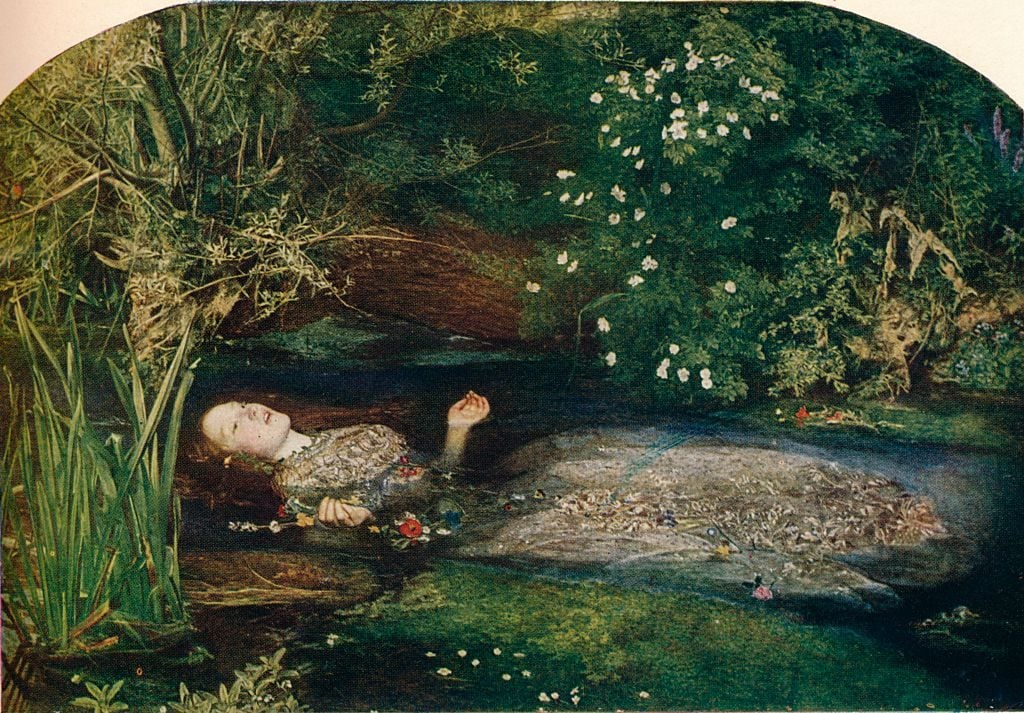
Secrets of John Everett Millais's painting, from its flower code to its model's fate.

Katie White

Two-and-a-half centuries after William Shakespeare’s Hamlet came to the stage, the tragic-romantic figure of Ophelia reignited the Victorian imagination in paintings, poetry, and plays. Among the era’s many Ophelias, none proved so indelible as Pre-Raphaelite painter John Everett Millais’s richly detailed rendering of the tragic heroine drowning. Now in the collection of the Tate, Ophelia (1851–52) is one of the defining images of the Pre-Raphaelite movement, encapsulating the Brotherhood’s emphasis on vibrant color, exacting detail, and literary themes.
In the painting, Millais has translated Shakespeare’s language—and Ophelia’s offstage death—into a vivid, psychologically charged image. The lovelorn noblewoman, distressed by the death of her father at the hands of her beloved Hamlet, is said to have wandered to a riverbank, tumbling into the river while collecting wildflowers.
Millais pictures Ophelia still alive but seemingly surrendering herself to death, hands upturned in a Christ-like gesture of surrender. She stares vacantly towards the sky, auburn hair spreading out around her in a mermaid-like halo.
Though widely beloved, the painting is still full of surprises. Here are three facts that might change the way you see John Everett Millais’s Ophelia.

The Hogsmill River, where John Everett Millais painted Ophelia. Photo by David Howard, via Flickr.
Though the painting centers on the drama of the figure of Ophelia, Millais actually spent the majority of his time painting the details of the landscape.
In a highly unusual decision, he painted the entirety of the scenery before even beginning the central figure. Millais started the painting July 1851, painting en plein air in Surrey. (The Pre-Raphaelites pre-dated the Impressionists in painting outdoors by some decades.) There, he would spend grueling months amid the fierce flies and challenging winds, meticulously observing flora.

Detail of Ophelia.
Despite his emphasis on the veracity of his botanical elements, the artist took a more-is-more approach to his scenery. Emblematic of the five months of dusk-til-dawn painting, it contains both spring and summer flowers blooming next to one another. Asked by Artnet News about the floral incongruities, landscape architect Dina Davis explained:
Of course, many flowers bloom over a long period of time. However, poppies like the one floating in the water have a short spring bloom. The spikes of purple flowers in the top right of the painting are purple loosestrife, which are late summer to fall bloomers. The roses are also midsummer bloomers in contrast to the violets and forget-me-nots which are spring bloomers.
Other flowers Millais added more as references to Hamlet, while still others to convey meaning to a Victorian population enthralled by flower symbolism. The violets which Ophelia wears in a chain around her neck, for instance, symbolized faithfulness, chastity, or death.
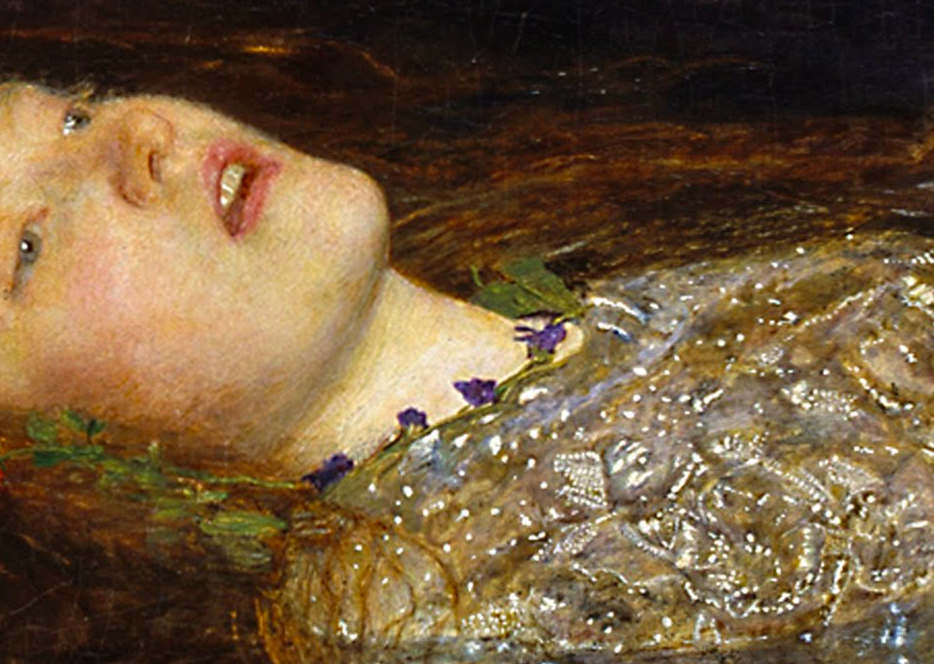
Violets in John Everett Millais, Ophelia.
The pansies on her legs represent unrequited love.
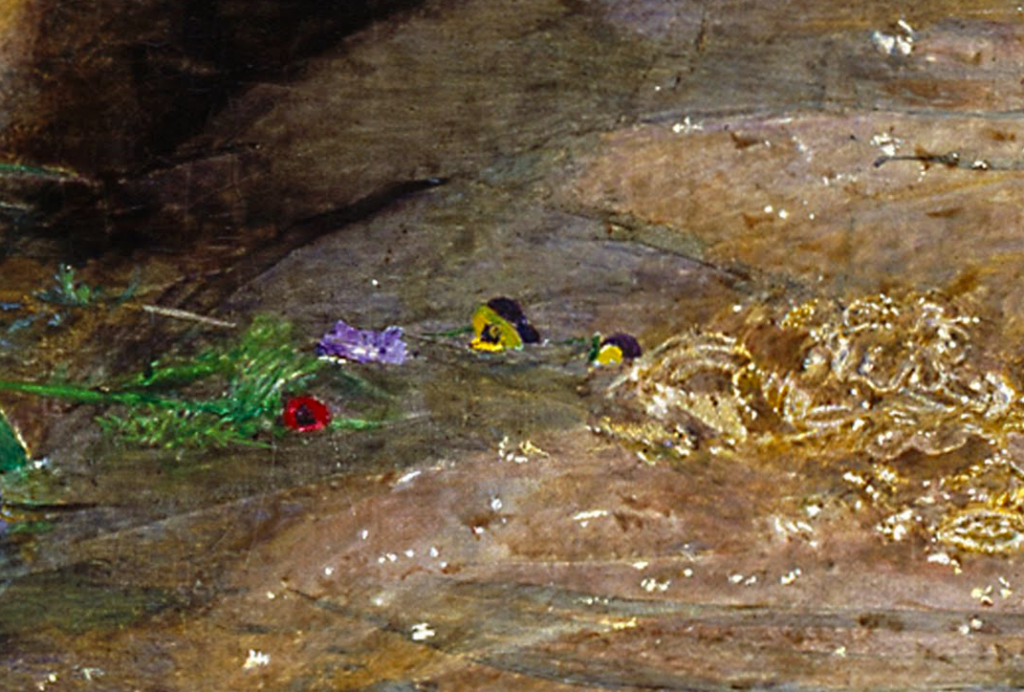
Pansies in John Everett Millais, Ophelia.
And the red poppy—never mentioned by Shakespeare—signified death.
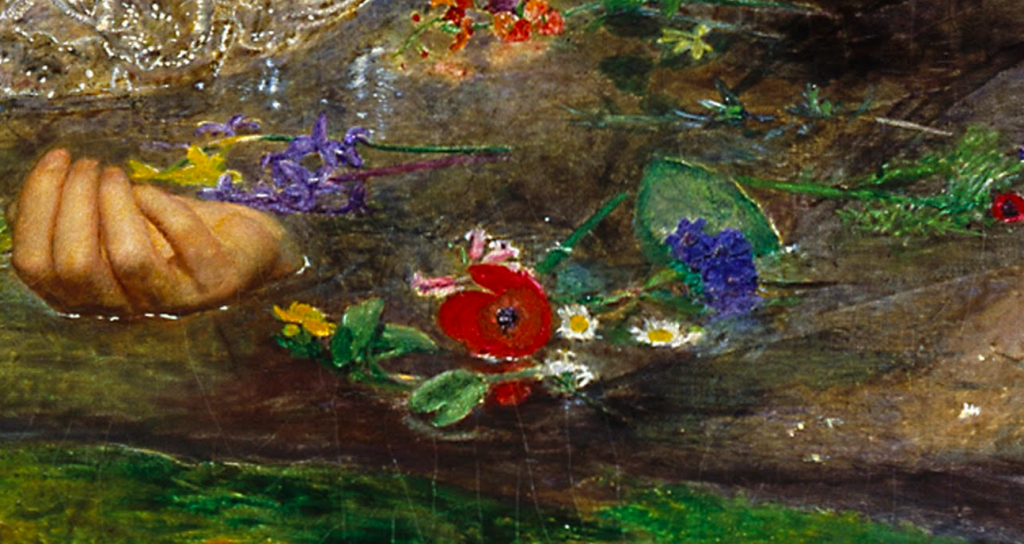
A red poppy in John Everett Millais, Ophelia.
Some critics were put off by the setting even so. “There must be something strangely perverse in an imagination which souses Ophelia in a weedy ditch,” wrote one critic.

John Everett Millais, Study for Ophelia (1852). Courtesy of Wikimedia Commons.
Elizabeth Siddal—a poet and painter and Pre-Raphaelite muse and future wife of Dante Gabrielle Rossetti—modeled for Millais’s Ophelia at just 19 years old.
To achieve the greatest sense of realism, Millais had Siddal pose in a full bathtub in his London studio wearing an antique silver dress he’d purchased especially for the painting. As Millais had fully devoted the spring and summer to the landscape, the work of painting Ophelia fell in the winter months. To keep the water warm, Millais improvised a system of lighting oil lamps and placing them under the bath.
But on one occasion, the lamps went out. Lost in his work, Millais failed to notice. Siddal, the consummate model, never broke her pose but subsequently came down with a severe cold, thought to have been pneumonia. Siddal accrued a number of doctor’s bills. When her father threatened Millais with legal action—and the artist, somewhat cowed, agreed to pay her medical bills amounting to some £50 (about £7,000 now).
Sadly for Siddal, poor health would plague her for the rest of her all-too-brief life. Ophelia, in the years that followed its unveiling, became, in the public imagination, an omen of Siddal’s own tragic story. The poppy Millais painted by Ophelia’s hand would gain a terrible new significance when in February 1862, Siddal, in the midst of postpartum depression following the stillborn birth of a daughter, overdosed on laudanum, an opiate derived from the flower, dying a few days later at the age of 32.
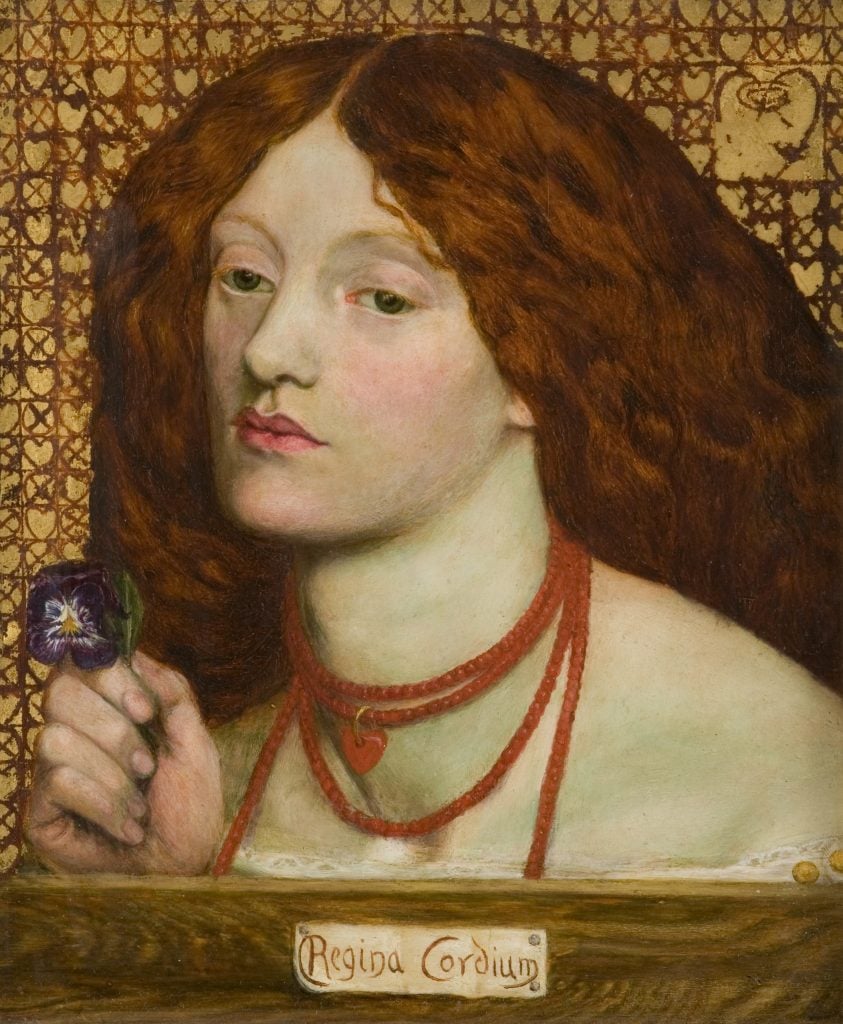
Elizabeth Siddal as the model of Gabriel Rossetti’s Regina Cordium (1860).
While it may be difficult to see today, when Millais debuted Ophelia in 1852, it scandalized critics. Pre-Raphaelite depictions of their models (often their wives, lovers, and sisters) dismayed the conventions of Victorian good taste. “The open mouth is somewhat gaping and babyish…,” wrote one critic. “There is no pathos, no melancholy, no brightening up, no last lucid interval.”
The English painter Joshua Reynolds had emphasized that the artist should attempt to idealize nature—including in depictions of female beauty. The Pre-Raphaelites, instead, chose unconventional looking women with heavy mantles of hair, hooded eyes, and full lips as their models.
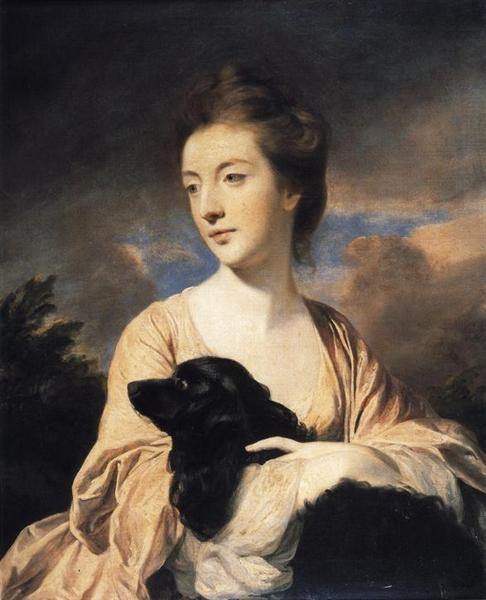
Joshua Reynolds, Lady Charles Spencer (1766).
These women’s bold looks disturbed Victorian viewers whose norms of beauty and grace emphasized the delicate and the demure. Pre-Raphaelite models like Siddal were considered to look at once masculine, overtly sexualized, and blatantly lower class. (This is actually a plot point in the 2009 BBC drama about the Brotherhood, Desperate Romantics.)
Nevertheless, by the 1870s, the very features had become widely admired in artistic circles, becoming further emboldened by the Aesthetic movement of artists and more widely embraced. In 1878, women’s author Mary Haweis wrote of the Pre-Raphaelites in The Art of Beauty:
those much-abused painters… are the plain girl’s best friends. They have taken all the neglected ones by the hand… All the ugly faces they have shown us have a certain beauty of their own… Red hair—once a social assassination … is the rage. A pallid face with a protruding lip is highly esteemed.
Within just 20 years, the artists had expanded the understanding of beauty. “As iconoclasts they all broke through certain barriers of form and style, reinventing the insipidness of contemporary beauty and substituting a more uncompromising, unsentimental if extravagantly personal vision,” Susan Casteras argues in “Pre Raphaelite Challenges to Victorian Canons of Beauty.” “Excess replaced restraint, and immoderation of face and pose brought abuse and galvanizing controversy as well as revitalization in English art.”